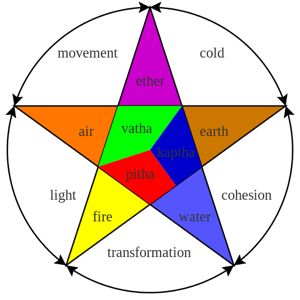- Home
- Guide for Essential Oil Use
- Ayurveda and Essential Oils
As an Amazon Associate and affiliate with other programs, I may earn revenue from qualifying purchases through affiliate links. This does not affect the price you pay. Privacy Policy / Disclosures. This site is for educational purposes only.
Ayurveda and Essential Oils For Balancing Doshas
Essential oils in ayurveda complement diet and lifestyle choices to balance your body based on your dosha and sub-doshas.
Ayurveda has five concepts, called elements:
- Earth represents solid matter (bones, teeth, and tissue).
- Water represents the fluids in the body.
- Fire represents bodily processes such as digestion.
- Wind represents gaseous processes in the body, including respiration.
- Ether represents space in the body.
The five elements combine to form three energies (humors or doshas) that govern the body:
- Vata (ether and air) is cold and dry.
- Pitta (fire and water) is hot and wet.
- Kapha (water and earth) is cold and wet.
You have a predominant dosha, plus each dosha has five sub-doshas, giving you a unique constitution. Ayurveda treats you based not only on your symptoms but also on your constitution. Thus, two people with the same symptoms may receive different treatments.
Ayurveda and Essential Oils
The best resource I have found about ayurveda and essential oils is Ayurveda & Aromatherapy: The Earth Essential Guide to Ancient Wisdom and Modern Healing. This book explains how to use essential oils in a way consistent with ayurvedic principles.
For example, essential oils either add heat or have a cooling effect on the body. Blue (German) chamomile is cooling, lavender is neutral, and thyme is hot. So, thyme would increase pitta, which is hot. Neutral oils balance the body and can either cool you down or warm you up.
Ayurveda also classifies essential oils as either wet or dry. Wet oils (for example, geranium and rose) mix well with water, while dry oils (for example, citrus oils and pine) float more on the surface of water. Because vata is dry, dry oils increase vata and wet oils decrease it, while wet oils increase pitta and kapha. Again, some oils, such as lavender, are neutral.
The book goes on to list essential oils appropriate for specific imbalances and also gives you ways to use the oils, including ayurveda massage.
Ayurveda and Aromatherapy for Dosha Imbalance
Imbalance in the doshas create physical symptoms. For example:
- Symptoms of kapha imbalance include low metabolic function, high cholesterol, trouble losing weight, fluid retention, depression, and lethargy.
- Symptoms of vata imbalance include premenstrual syndrome, constipation, insomnia, restlessness, nervousness, anxiety and worry.
- Symptoms of pitta imbalance include frustration, anger, emotional upsets, and high blood pressure.
Source: KG Stiles Essential Oils and Aromatherapy Library
Balancing oils for each dosha:
- Balancing oils for vata include bergamot, cardamon, cinnamon leaf/bark, clary sage, clove, frankincense, ginger, lemon, nutmeg, orange, patchouli, and rose.
- Balancing oils for pitta include roman chamomile, geranium, helichrysum, jasmine, neroli, peppermint, sandalwood, and ylang ylang.
- Balancing oils for kapha include basil, bergamot, black pepper, clove, eucalyptus, fennel, frankincense, juniper, lemon, nutmeg, orange, peppermint, rosemary, sage, and spearmint.
Source: Aromatherapy: A Complete Guide to the Healing Art
Examples of ayurvedic essential oil properties:
- Myrrh is drying. It balances all three doshas but can aggravate pitta in excess.
- Rose is bitter, pungent, and astringent and also sweet and cool. The oil cools and soothes, balances all three doshas, and eliminates pitta from the mind and eyes.
- Sandalwood is bitter, sweet, astringent, and cool. It controls the doshas but has more physical effects on pitta. The oil lightens and concentrates the mind.
- Spikenard balances all three doshas, promotes awareness, and strengthens the mind.
- Tulsi (holy basil) is pungent, bitter, and hot. It controls vata and kapha but can increase pitta. This oil has many uses, including purifying and eliminating toxins, expelling mucus, and reducting spasm.
- Vetivert is bitter, sweet, and very cooling. It strongly reduces pitta and reduces kapha.
Source: Essential Oils: A Handbook for Aromatherapy Practice
Ayurvedic Essential Oil Blends
Kapha Balancing Massage Oil
- 2 ounces (4 tablespoons) organic sesame oil
- 5 drops rosemary ct. verbenone essential oil
- 3 drops Eucalyptus smithii essential oil
- 3 drops Eucalyptus dives essential oil
- 5 drops tulsi (holy basil ) essential oil
- 6 drops Himalayan cinnamon (Cinnamomum cecidodaphne) essential oil
- 5 drops lemon essential oil
Source: Radha Crawley, "Exploring Ayurveda: The Language of Nature in Spring," NAHA Aromatherapy Journal, Spring 2013.1, p. 15.
Pitta Balancing Massage Oil
- 2 ounces (4 tablespoons) organic coconut oil
- 6 drops vetiver essential oil
- 5 drops lavender essential oil
- 4 drops rose essential oil
- 3 drops champa (Michelia champaca) oil
- 2 drops clary sage essential oil
- 1 drop rose geranium essential oil
- 1 drop lime essential oil
Source: Radha Crawley, "Exploring Ayurveda: The Language of Nature in Summer," NAHA Aromatherapy Journal, Summer 2013.2, p. 26.
Image Credit: Krishnavedala (Own work) [CC0], via Wikimedia Commons







